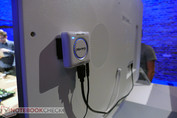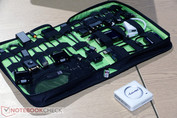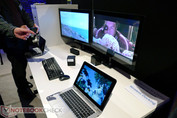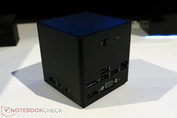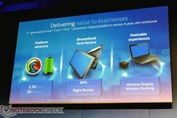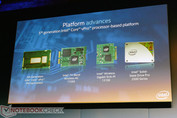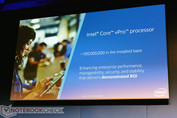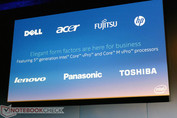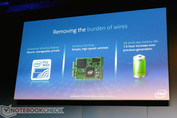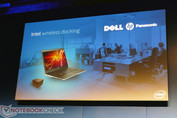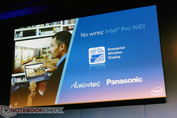With the CPU market under tight control, Intel now expands its attention to other technology. The company has now revealed which of the announced Broadwell-U and already existing Broadwell-Y (Core M) processors will support the advanced vPro capabilities, which now include Pro WiDi (Wireless Display) and Wireless Docking. Here is the list of models along with their prices and main specifications:
| Product Name | Launch Date | Cores | Clockspeed | Cache | TDP | Price | Processor Graphics |
|---|---|---|---|---|---|---|---|
| Intel Core i7-5650U | Q1'15 | 2 | up to 3.20 GHz | 4MB | 15W | 426 USD | Intel HD Graphics 6000 |
| Intel Core i7-5600U | Q1'15 | 2 | up to 3.20 GHz | 4MB | 15W | 393 USD | Intel HD Graphics 5500 |
| Intel Core i5-5350U | Q1'15 | 2 | up to 2.90 GHz | 3MB | 15W | 315 USD | Intel HD Graphics 6000 |
| Intel Core i5-5300U | Q1'15 | 2 | up to 2.90 GHz | 3MB | 15W | 281 USD | Intel HD Graphics 5500 |
| Intel Core M-5Y71 | Q4'14 | 2 | up to 2.90 GHz | 4MB | 4.5W | 281 USD | Intel HD Graphics 5300 |
| Intel Core M-5Y70 | Q3'14 | 2 | up to 2.60 | 4MB | 4.5W | N/A | Intel HD Graphics 5300 |
Intel Pro Wireless Display
Intel's Wireless Display (often shortened as WiDi or Wi-Di) technology uses Wi-Fi Direct protocol for wireless video casting, much like Miracast in Android devices. Unlike Miracast though, it's locked to all-Intel hardware: to support WiDi, a device requires to use one of the supported Intel Core processors with access to its integrated graphics (thus, all laptops with dedicated GPUs and Optimus/Enduro graphics switching disabled can be ruled out) and an Intel wireless module (a few Broadcom ones are also listed as supported). However, the unquestionable reality is that majority of laptops and Windows 8 tablets and convertibles on the market right now are powered by Intel processors and do have access to their integrated graphics (some gaming laptops such as Asus G751JY being the most notable exceptions). Even if an incompatible wireless module is used, in most laptops it can be easily swapped. Supported operating systems Windows 7, 8 and 8.1.
On the monitor or projector side, support for WiDi or Miracast (included into WiDi specification since version 3.1) is also required. If not inbuilt, it can be added by purchasing a receiver device (see Intel's certified list) which plugs into an HDMI port and is powered by either USB or its own power adapter. Screen casting can then be done at up to 1080p resolution or up to 2160p (for Broadwell based devices only) including audio transfer (up to 5.1 surround). Most of WiDi receivers will also accept Miracast connections available on the majority of new Android devices and select laptops (such as the above-mentioned Asus G751).
The Pro version of this technology adds support for advanced features such as multiple display sharing, access control management and encrypted connection. These differences are supposed to make it more appealing for business environments, but CPUs with vPro support are required to utilize them. The above list of compatible processors should help the buyers looking for a Broadwell-powered device to be used with Pro WiDi. Devices with processors without vPro support should theoretically still be able to connect to Pro WiDi receivers and vice versa but with less features supported.
Intel Wireless Docking
We have already covered the basics of Wireless Docking recently with HP's new Elite x2 1011 G1 which can be configured to support this technology. As suggested by its name, it allows a device to be wirelessly docked to a compatible dock station - HP already offers one for their new Elite x2 1011 G1. To enable Wireless Docking support, a device (laptop, utlrabook, tablet or convertible) must satisfy the same conditions as described above for WiDi support, but the installed processor must support vPro and the only wireless module supported so far is Intel Wireless-AC 17265. The reason for this is the new 60 GHz band utilized by Wireless Docking which is missing in the majority of wireless modules on the market. While higher frequency shortens the useful signal range, it also improves the maximum bandwidth (up to 7 Gbps, as specified by the IEEE 802.11ad "WiGig" protocol), which is perfect for wireless docking: users will most likely place their device in the same room as the wireless docking station and require a very high-speed and low-latency connection established between the two in order to emulate the wired dock station experience. Intel promises to deliver both.
Once configured, the setup works just like a normal docking station: peripherals such as screens (up to 2 at once), USB 2.0/3.0 devices, audio equipment and Ethernet network can be connected and accessed by the device. Intel's cube-shaped reference docking station, for example, offers two full-sized DisplayPort inputs, a VGA port for older screens and projectors, two 3.5-mm jacks (audio input and output), an Ethernet jack and four USB 3.0 ports. Other manufacturers will certainly offer solutions with comparable functionality - in fact, some already exist since more than a year but Intel now wants the technology to become ubiquitous in work environments. It should also eliminate the practice of manufacturer-specific docking interfaces purposefully obsoleted every couple of years to generate sales: a Wireless Docking station will connect to any device satisfying the above-mentioned requirements. To facilitate security, Intel added 128-bit AES encryption to prevent sniffing of the connection between the device and the docking station.
Intel demonstrated their reference docking station paired with laptop 5 meters away from it. The connection took about 5-10 seconds to establish but once negotiated, it allowed an Ultra HD 4K (3840x2160 pixels) video stored on a USB 3.0 disk attached to the docking station to be simultaneously shown on the laptop's internal screen and the two displays connected to the docking station. We have taken some pictures of the presentation - they can be found below.


 Deutsch
Deutsch English
English Español
Español Français
Français Italiano
Italiano Nederlands
Nederlands Polski
Polski Português
Português Русский
Русский Türkçe
Türkçe Svenska
Svenska Chinese
Chinese Magyar
Magyar
